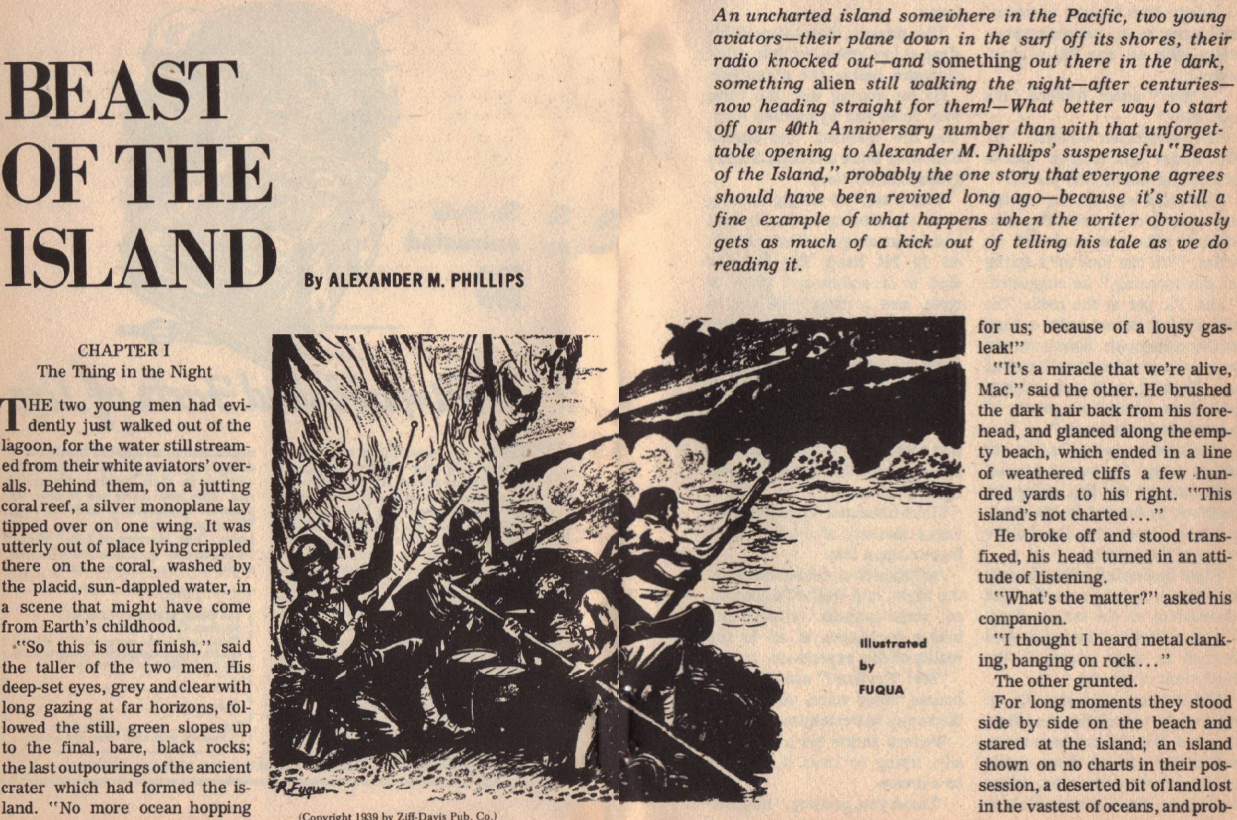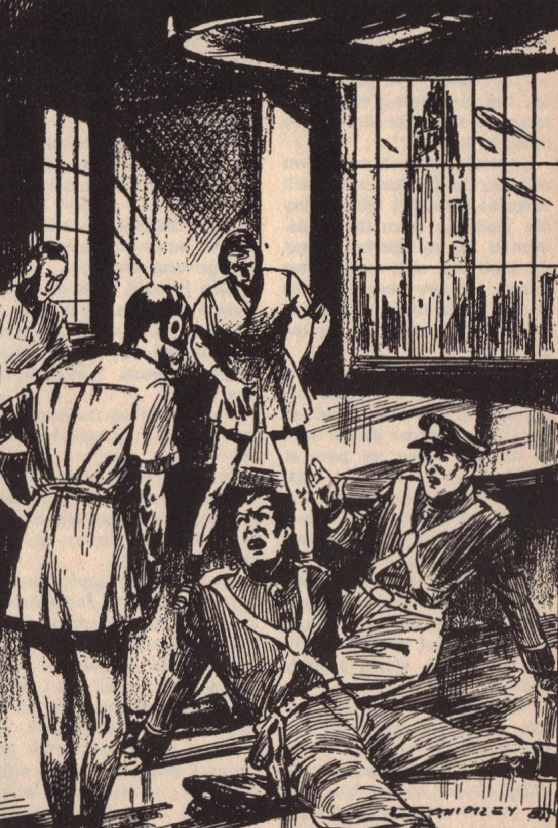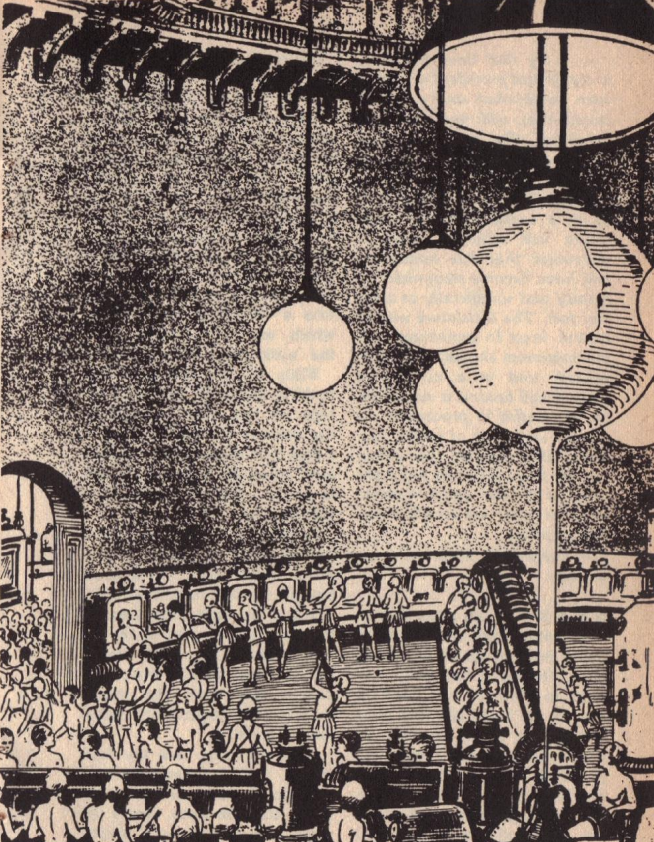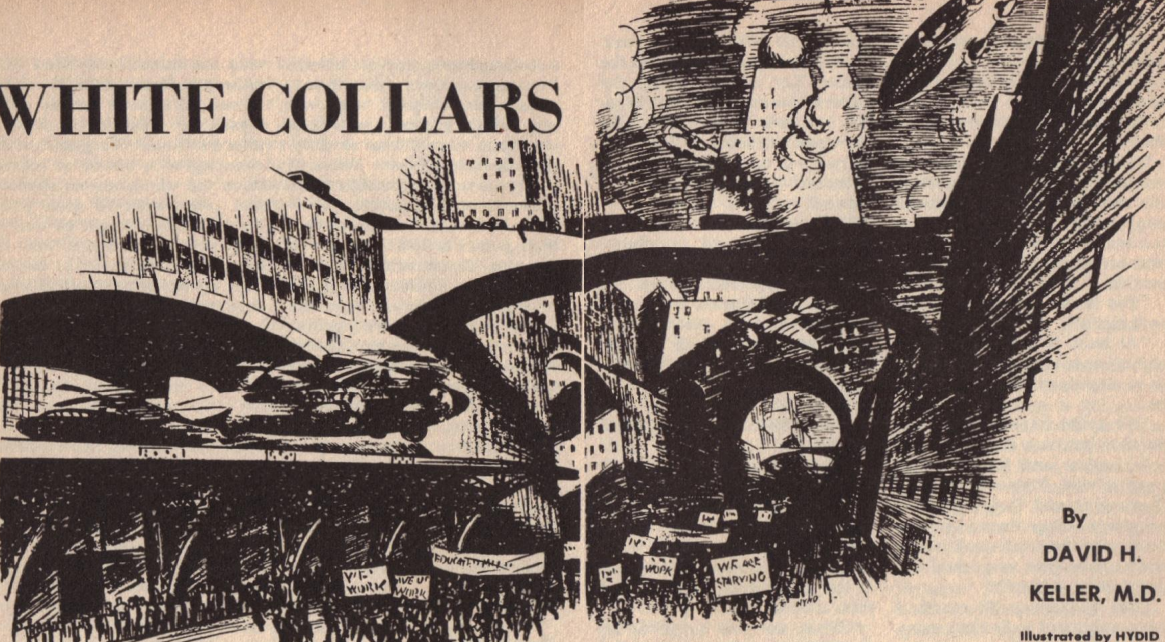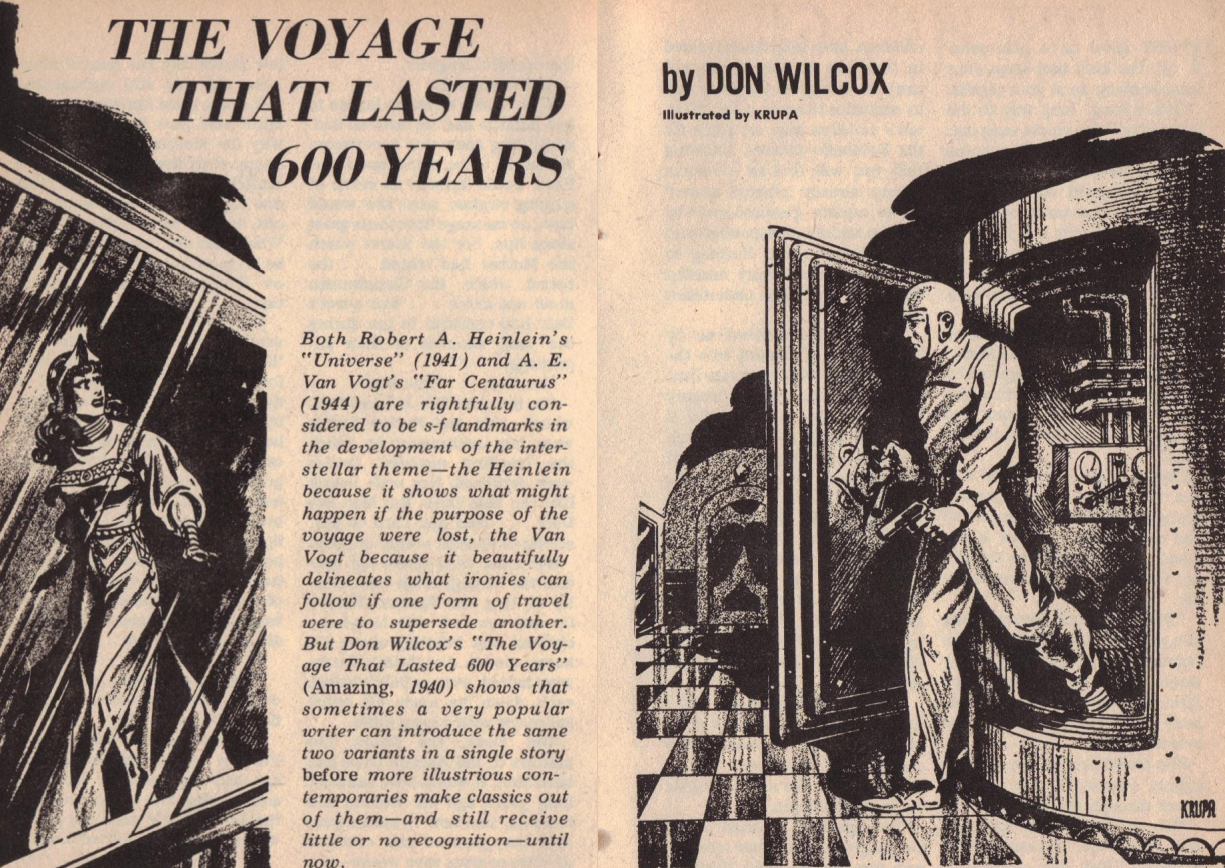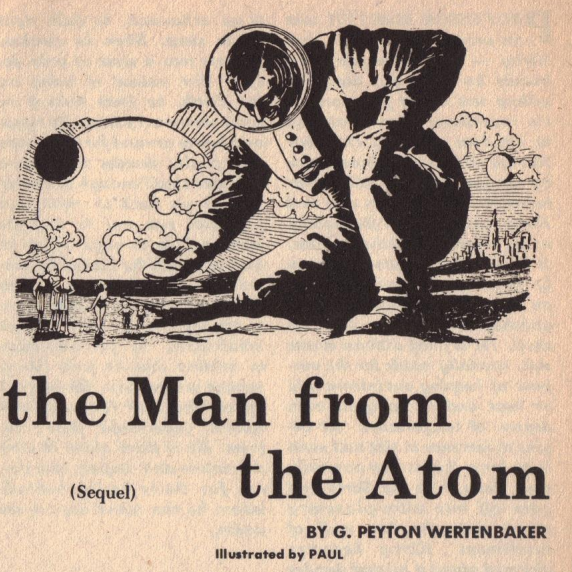
by John Boston
A Fresh Heir
We have been harbinged. When Harry Harrison, recently departed as editor of SF Impulse and suddenly appeared as book reviewer in this magazine that seemed to have eschewed features entirely, I wondered whether it was an omen of a larger change.
And here that change is, in big letters at the top of the cover of this December Amazing: “HARRY HARRISON New Editor.” Joseph Ross is gone from the masthead and his departure is unheralded elsewhere in the magazine, though Harrison is quite gracious to him in his book review of Ross’s anthology The Best of Amazing.

by Johnny Bruck
Otherwise, the kudos are reserved for the recently-deceased Hugo Gernsback. Harrison’s editorial is a tribute to him, and Science Fiction That Endures, Gernsback’s own guest editorial from the April 1961 anniversary issue, is reprinted. Gernsback says among other things that enduring SF stories are those that “have as their wonder ingredient true or prophetic science,” and notes that Jules Verne and H.G. Wells wrote most of their notable SF early in their careers, later succumbing to “science fiction fatigue—the creative science distillate of the mind had been exhausted.” That sounds scientific!
But does this change in masthead mean any actual material change in this too frequently lackluster magazine?
The most visible difference is that the cover and title page have suddenly become more crowded. Nine items are touted on the cover, five of them touted as “NEW” and others as “SPECIAL” or even “XTRA SPECIAL.” There’s so much puffery going on that the cover illustration, by Johnny Bruck from the German Perry Rhodan periodical, is confined to the bottom third of the cover, though little harm is done, since it’s quite horizontal in orientation, depicting a spaceship traveling very low and being pursued by flying snakes. Beat that, Frank R. Paul!
Other aspects of the magazine’s presentation represent both continuity and change. The proofreading is still terrible; look no farther than the misspelling “Lester del Ray” on the title page of his story. And curiously, part of the magazine—pages 90 through 125—is in a different, smaller typeface than the rest, though this increase in wordage is not touted on the cover or elsewhere.
As to the contents, the balance is shifted only a little. Two short stories and the serial installment are original, one story is probably reprinted but this is its first appearance in English, and four short stories are reprinted from earlier issues of Amazing and Fantastic. And of course we don’t know whether Harrison actually had much of a hand in selecting what went into this first issue of his incumbency. But the question of reprints versus new material seems to be a continuing sore point. Note the column on the left side of the cover—five iterations of "NEW"—which musters everything in the magazine that's not a reprint, including the book review column.
So, too early to tell, but promising—it almost has to be, given Amazing’s doldrums of mediocrity to date under Sol Cohen. As Bob Dylan, the alleged troubadour of my generation, put it:
I wish I was on some Australian mountain range.
I wish I was on some Australian mountain range.
I got no reason to be there, but I imagine it would be some kind of change.
Santaroga Barrier (Part 2 of 3), by Frank Herbert

by Gray Morrow
First, to the non-reprinted fiction. The longest piece of fiction here is the second installment of Frank Herbert’s serial Santaroga Barrier, in which the suggestively named Gilbert Dasein tries to unlock the secret of the reclusive town of Santaroga, which seems to involve a psychoactive substance called Jaspers that the locals all consume. As usual I’ll hold my comments until the story is complete.
The Forest of Zil, by Kris Neville

by Jeff Jones
Kris Neville, who contributed prolifically to the SF magazines during the early 1950s but slowed down considerably thereafter, opens the issue with The Forest of Zil, a cryptic story of space explorers who land on a planet entirely covered in forest and begin to make plans to clear trees to make space for human activities. The forest begs leave to differ, and its response can be read either as an epic in brief of raising the ante exponentially, like A.E. van Vogt but not as noisy, or as a weary parody of the entire conceptual armamentarium of SF. Or maybe something else! How many faces can you find lurking in the coffee shop placemat? Four stars for this subtly memorable piece.
The Million Year Patent, by Charles L. Harness

by Jeff Jones
Charles L. Harness, a patent lawyer by day, is present with The Million Year Patent, in which the technicalities of patent law collide with those of relativity, not very interestingly to this lay person. Two stars.
An Unusual Case, by Gennadiy Gor
The “Sensational Story from behind the Iron Curtain” per the cover is Gennadiy Gor’s An Unusual Case, translated from Russian by one Stanley Frye. Gor, born to a family exiled to Siberia by the Tsar, was apparently part of the avant-garde in the Soviet Union in the 1920s, but survived to write popular science texts as well, and to start writing SF in 1961. There’s no indication where this story was previously published, if at all. It’s a first-person account by the creator of an artificial intelligence (apparently at least humanoid; a hand is mentioned) of his rearing of this pseudo-child, which is cut short when representatives of the corporation that financed the project come to take it away, as it protests piteously. It’s short and poignant, though blunted a bit by not making much sense; the ingenue develops detailed memories of human life that its creator didn’t put there. Three stars, and I hope we see more of Gor’s work here (or anywhere).
The Smile, by Ray Bradbury

by L. Sterne Stevens
The ”Ray Bradbury Masterpiece” touted on the cover is The Smile, from the Summer 1952 Fantastic, set in what seems like an American town after a nuclear war has mostly destroyed civilization and left everyone who survived destitute. People of course respond in the only logical way—by destroying or defiling any available relics of the former civilization. A while back it was smashing an old car with sledgehammers; today everyone is lining up to spit on a fragment of a famous painting (clue: the title). But young Tom just can’t get with the program. It’s a bit overdone, but Bradbury’s overdone is better than many writers’ perfectly-baked. Or something like that. Three stars.
Stacked Deck, by Lester del Rey
Our Journeyer-in-Chief recently had occasion to mention “the sort of inferior stuff that filled the lesser mags of the ’50s.” Here’s the real article, Lester del Rey’s Stacked Deck from the November 1952 Amazing. Del Rey is one of SF’s hardy journeyman professionals, in the game since 1937 as writer, first for John Campbell’s Astounding and Unknown, then for everyone in sight during the 1950s’ efflorescence of SF magazines. In the ‘50s he edited magazines and anthologies and wrote novels as well as stories, including a prodigious ten of them under various pseudonyms for the Winston series of juvenile SF. Occasionally he excelled, and his work almost always maintained a basic level of competence.
Almost always. Sometimes a working writer just has to crank it out, inspiration or no, as in this excruciatingly contrived piece. Before it opens, a man flew to the moon, without enough fuel to get back, expecting to be rescued in time by a later expedition. (This already makes no sense.) But that rocketeer, inexplicably, showed up again on Earth, talking about entities he encountered on the moon but claiming scrambled memory. So a better-equipped expedition sets out, only to discover that the Russians are neck and neck with them. All this is told in an annoyingly jaunty, I’m-just-a-regular-guy first person style, as in the opening sentence: “The bright boys with their pep talks about space and the lack of gravity should try it once!”

by Ed Emshwiller
Upon landing, our heroes find a building with an airlock, and inside, a nice lounge with red leather chairs, a cigarette machine, and plenty of alcohol and food, along with a machine shop and a lot of electronic gear, with signs and manuals in English and Russian—and a vault full of missiles, ready to be armed with warheads. They surmise the Russians are finding something similar.
So what gives? All along there have been passing references to gambling, such as the protagonist’s having bought a sweepstakes ticket, and racing magazines lying around, some inside the mysterious building. Our hero picks up one of the latter and finds a note in it written by the aliens who set up the building, explaining that they are all betting on whether the Earthfolk will blow themselves up in short order, or avoid extermination and come calling on the aliens a bit later. Narrator ruminates: “I don’t like being the booby prize in a cosmic lottery. And that’s all the human race is now, I guess.”
And that arid gimmick is the story, with no other redeeming feature. Del Rey must have been short on the rent that month. One star.
Luvver, by Mack Reynolds
Speaking of gimmicks, arid ones that is, Mack Reynolds’s Luvver (Fantastic Adventures, June 1950) is about as contrived as Stacked Deck. Old Donald Macbride and his flirtatious daughter Patricia are having spaceship problems and make an emergency landing on a handy planet despite the “RESTRICTED ZONE. LANDING FORBIDDEN” warning that comes over the radio. The local garrison, consisting of Steve and Dave, hustles them off their ship—blindfolded—and into their quarters, warning them not to look around, not to go outside, not to open the windows, without explaining why.

But Patricia, of course, goes outside, and before Steve can drag her in, she sees a little animal–a luvver. He knocks her out and the guys shoot her up with “the lethe drug,” since wiping her memory is her only hope. Steve explains to the old man that all animals have means of defense—speed, size, venom, scent, etc. The luvvers’ defense is eliciting undying love—“a stronger force than the most vicious narcotic”—in anyone or anything that sees them. If Patricia retains her memories, she will “die of melancholy” if kept away from them, and if they escaped their world, pandemonium would ensue.
The gimmick is slightly less inane than del Rey’s, and Reynolds writes in a style more facile and natural than del Rey’s artificial and irritating voice, so two stars, barely.
Sub-Satellite, by Charles Cloukey
The gem of the issue, remarkably, is Charles L. Cloukey’s Sub-Satellite, from the March 1928 Amazing. It recounts a great inventor’s construction of a spaceship and his voyage to the Moon in it, and the attempt on his life there by a disgruntled and demented former employee who has stowed away. It is well told in an agreeable, slightly stilted but very plain style with a good balance of narration and exposition, reminding me of (my old memories of) Jules Verne. It too ends with a gimmick—one that has been used in later decades by better-known writers—but there’s much more of a story here than in del Rey’s or Reynolds’s efforts, so it doesn’t detract from the whole. Four stars.
So who’s this Cloukey? Never heard of him, though I’m familiar with most of Gernsback’s repeat contributors. Turns out he died in 1931, at age 19, of typhoid fever, after publishing eight stories, a poem, and a serial novel in Gernsback’s magazines. Sub-Satellite was his first story, and he was not quite 16 when it was published. Forget G. Peyton Wertenbaker, whose The Man from the Atom, done when he was 16, was pretty terrible—Cloukey is the real prodigy of the Gernsback years. Too bad he didn’t last.
Summing Up
So, not a bad issue, with a couple of four-star stories, and some evidence (mainly the cover and table of contents) that the new regime at least wants to make the magazine look a bit livelier. Whether a sustained improvement is in process of course remains to be seen.

![[November 20, 1967] Fresh Air? (December 1967 <i>Amazing</i>)](https://galacticjourney.org/wp-content/uploads/2022/11/amz-1267-cover-497x372.png)

![[August 20, 1967] Hugo Gernsback, 1884-1967](https://galacticjourney.org/wp-content/uploads/2022/08/gernsback-1929-486x372.png)


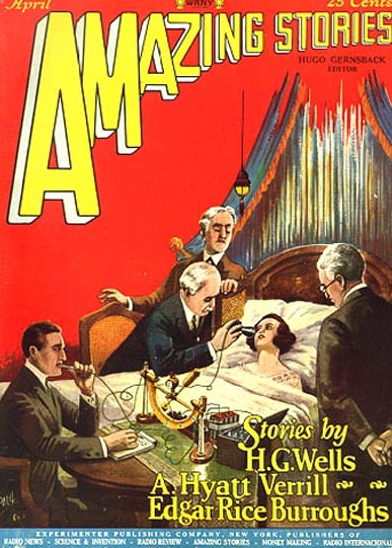






![[March 6, 1966] Is More Less? (April 1966 <i>Amazing</i>)](https://galacticjourney.org/wp-content/uploads/2021/03/amz-0466-cover-448x372.png)


